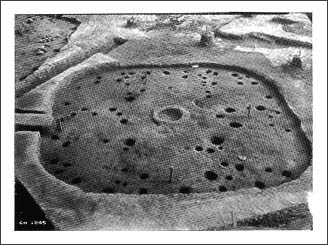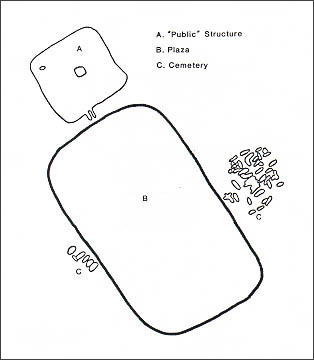by Lynne P. Sullivan, New York State Museum
[NOTE: A phase is an archaeological term designating a group of sites that are similar in time period, archaeological features, and artifacts, and which are located in the same geographic locality. A phase represents the remains of a specific culture, or way of life.]
The Mouse Creek phase dates to the early European contact period in the southeast United States (approximately AD 1400-1600). Archaeological sites belonging to the phase are located along the Hiwassee River and adjacent portions of the Tennessee River in southeast Tennessee. The most extensive excavations of Mouse Creek phase sites were made in the 1930s by the University of Tennessee in conjunction with federal Works Progress Administration programs and construction of the Tennessee Valley Authority’s Chickamauga reservoir. Collections from these excavations now form part of the permanent holdings of the McClung Museum.
Although flat-topped earth mounds are associated with sites of other contemporaneous phases in the mid-south, no mounds have been found at Mouse Creek phase sites. Instead, the plans of larger Mouse Creek settlements include a large structure situated beside an open area, or plaza, surrounded by smaller structures. People were often buried in and around these smaller structures and sometimes in concentrated cemeteries next to the plaza.
Archaeologists can discern much information about how past cultures were organized by studying the arrangements, or plans, of their settlements. This is possible because people often arrange their dwellings and public buildings in ways that reflect organizing principles of their societies. For example, people belonging to the same kin group or social status might live in close proximity. Another important source of data for this topic is the customs used in burying the dead. How individuals are treated in death often mirrors their social status or special roles in society related to their age, sex, abilities, or family relationships. Mouse Creek phase sites are particularly well suited for archaeological studies of social organization, as both sources of information are available.

Figure 1.
In the case of Mouse Creek phase settlements, the smaller structures found at a site most likely represent dwellings. Careful examination of the archaeological features, including patterns in the soil left by posts (dark circles in the photo at Figure 1) and placements of graves, indicate that the typical Mouse Creek phase residence consisted of a substantial structure (a “winter” house) adjacent to a flimsier structure (a “summer” house). Most burials occur around the latter type of structure, but infants and young children sometimes were interred in the floors of the winter houses. This paired type of residence with a “household” cemetery is typical of several historically known southeastern Indian groups and earlier contact period archaeological phases. The photo at Figure 1 shows the excavated floor of a winter house at the Rymer site.
Study of the ages and sexes of the Mouse Creek burials and the kinds of objects interred with them suggests social differences between individuals buried in the household areas and those buried in the cemeteries adjacent to the plaza. All ages and both sexes were buried in the household cemeteries, but plaza burials contain many more adult males than males of other ages or females. Also, the artifacts associated with plaza burials include many different and well-made items not found with household burials. These differences undoubtedly reflect the different roles or positions these individuals held in society. Probably those individuals buried near the plaza were leaders, both secular and/or religious, while the individuals interred near houses did not hold such positions of community-wide authority.

Figure 2. Public Sector Ground Plan.
Finally, when the plan of the entire settlement is considered, it is apparent that “public” and “private” sectors exist: the public sector includes the large structure (probably a council house), the plaza, and adjacent cemeteries (Figure 2); and the private sector consists of individual residences (winter and summer houses) and their associated burials (Figure 3). The public sector mirrors organizationally the private one, that is, the council house is a larger version of the winter house, while the plaza represents the community’s “summer” or outdoor space just as a summer house was used for a family’s outdoor space. Similarly, cemeteries are located adjacent to the plaza (summer space), just as family burials are placed next to their summer houses.

Figure 3. Private Sector Ground Plan.
This summary only touches the surface of the types of studies that can be done to understand how past peoples organized their communities. The availability of extensive and detailed field records and collections like those curated at the McClung Museum is essential for refining interpretations and generating new ideas about these extinct cultures.